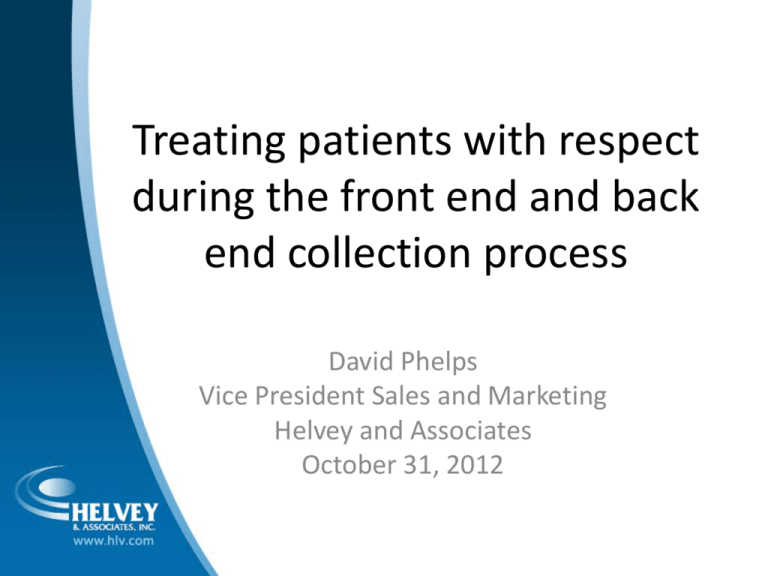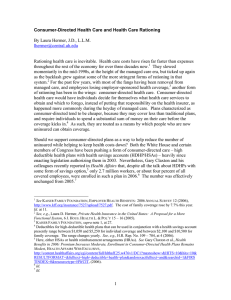Collection Processes - David Phelps
advertisement

Treating patients with respect during the front end and back end collection process David Phelps Vice President Sales and Marketing Helvey and Associates October 31, 2012 Agenda • Building a Culture • Training – It Starts at Day 1 • Quality Assurance • Being where the patients are • The Real World Health Care is Consumer-Driven • The current trends show an increase shift across the industry for patients to take more responsibility for Healthcare spending • Payers shifting financial responsibility to the patient • Employers are shifting healthcare costs to employees • Healthcare providers are seeing a shift in payer reimbursement to patient (self-pay) • Medicare holding steady at $135 Deductible and 20% Coinsurance • Government is promoting Consumer-Driven Healthcare as a means of slowing the growth of national healthcare spending The Real World • Trying economic times • More and more competition • Not all of the PR is positive What are you doing to accommodate your patients changing needs? Building the culture of respect and fairness from the top down • Ways to accomplish – Guiding Principles – Open communication from the top down • Builds respect – Employee meetings – Regular staff meetings – Make the job fun – External motivation Training and Development • Introduce culture at the onset – attract more flies with honey • Emphasis on communications technique – before process training! • Assertive not aggressive – assertive is asking for what you want, refusing what you don’t want – The art of negotiation – Empathy not Sympathy • Don’t take rejection personally Motivating patients to pay! Front Desk Procedures with HDHP • Difficult for front desk personnel to identify HDHP patients – Most of the time, only PPO is stated on the card • Need to incorporate patient verification procedures – Identify total plan deductible – Either % of deductible met or remaining deductible amount • If not contracted with plan, financial counselors should negotiate with patient or plan, and try to collect 75% to 100% up front • If patients are identified with a participating HDHP, consider collecting 75% of estimated visit costs during check-out • Communicate payment expectations with patient upon verification and again at check-in New Philosophies in Preregistration and Registration Processes • Shift of revenue cycle activities upstream from business office to front-end/patient access functions • Patient verification is the key to identifying HDHP patients • Develop an up front collection policy that is communicated with patients • Receptionists need to be prepared to estimate a payment amount and communicate with patients • Make use of financial counselors in communicating payment arrangements with patients Front-end Collection Components • Collecting patient responsible payments at time-of-service can reduce accounts receivable by over 15%. • Review of payer’s fee schedule of the top payers • Incorporate fee schedules into information system. • “Best” opportunity to collection patient’s portion of visit. The Earlier You Communicate, The More You Collect • Estimated Collection Percentage by Front-desk Function – Check-in – Check-out – On month after visit: 90% 70% <40% • Prior to visit, healthcare is the greatest priority to patients – Psychological advantage for healthcare provider in collecting at check-in – Following the visit, healthcare drops to last priority and the “debt” becomes the high priority Tips on Improving Front-end Collections • Help staff understand what to collect and how to ask • The more comfortable your staff is on collecting, the greater your success • Provide receptionist/financial counselors with the right tools – Fee schedule and estimated exam fees – Practice management system as a guide – Collection policies and protocols • Deploy signage and “patient-friendly” collection campaign within the office • Share the collection burden Training Staff to Collect Money • Practice “Open Book” Management – Present to staff front desk collection variance • Remove delineation between clinical, registration and collection functions – Obtain buy-in from physicians prior to collection initiative • Deliver “Kick-Off” meeting to initiate new processes – Create clear and definitive change of process and policy • Provide consistent support – Financial counselor – Collector “Hot-Line” Training Staff to Collect Money • Provide simple training tips and tricks for front desk collection appeals – Tap back office collection / customer service staff to assist training – Collection agencies will often offer to present modified versions of their own presentations • Construct role-playing scenarios • Create desktop laminated “go to” phrases for easy access. – “We can accept Mastercard, Visa, checks or cash to fulfill your responsibility of $___ for today” Training Staff to Collect Money • Provide multiple “payment avenues” – All credit cards / debit card alternatives – Payment plans – Pre-payments • Empower registrars to work with patients – Provide increased lenience for patients during introductory period – Create a 3 Strike Rule • 3 times patient defers payment and does not satisfy balance within 30 days = rescheduled appointment • Exceptions allowed with justification Training Staff to Collect Money • Create Incentives – Monthly bonuses for registrars based on collection thresholds • Co-Payments • Outstanding balances – Contests • Support registrar collection initiatives – Front desk delays – Re-scheduled appointments based on financial issues – Stress physician patience QA Programs • Before you begin – Justification of cost of program • Can you afford not to establish? – Executive buy in! • Things to think about when developing your program – Objective measurements • Difficult as customer service requires on the spot judgment – Consistency • Standard audit frequency – weekly / monthly ensures fairness – Minimize staff responsible for audits – Tie individual audit results to performance evaluation—so employees take program seriously – Thoroughly explain program to staff before implementing • Get better buy in QA Programs • Implementing your program – Don’t move too fast! – Trial period before tying to performance evaluation • Are you standards too high or low? – Quality over quantity • How many calls can be audited conclusively? – Review and refine—continual • Add or subtract criteria • Change weights of criteria • Re-examine quality standards Being Where Your Patients Are • Are you a bank? – What are your hours of operation? – What happens to patients before 8am and after 5pm? • How do you communicate with your patients? – Electronic vs paper vs phone vs website… • Responsiveness The Cleveland Clinic Enterprise Solution IVR Online Registration Itemized Statement Enterprise… Paper Statement MyAccount Customer Service Department Enterprise Statement • Created by combining over 140 files from various systems across the enterprise • Majority of patients will receive a combined enterprise statement • They will continue to send patients separate statements if we can not verify enough demographic information to create a combined statement MyAccount • Patient friendly tool for online bill payment • Phased rollout began 2010 MyAccount Features Phase 1 • • • • • • • QuickPay • Credit card/E-Check payment • Prompt Pay Discount • Payment plan option • Email/print receipt MyProfile Links to Online Registration, maps and directions, make an appointment, MyChart Historical activity Pre-enrollment Link multiple patients to guarantor FAQs Phase 2 • Request itemized statement • Ability to detail post payments • Ability to complete loan application online • Addition of PayPal to MyWallet Customer Service and IVR • • • • • Single call center for the enterprise Self service IVR Ability to make payment arrangements, offer discounts for prompt pay and provide information regarding loan program Employees cross-trained East, West, Main and Florida systems Developing a database to request updates to data in decentralized host systems But I’m not the Cleveland Clinic! • Which pieces can you implement? – Priorities – Patient Comments • Partnerships – The right partners for the right solutions! • Put your money where your mouth is! – Are you delivering what you are you telling your patients? Thank You! David Phelps VP Sales and Marketing Helvey and Associates 800-735-0730 ext 373 dphelps@hlv.com








